
History
Upon a vast expanse of open prairie, Greenfield became a settlement in 1854 and later formally incorporated.
Iowa was opened to settlers in 1832, but by mid-century, the plains of this area were yet foreign to all but a few nomadic First Americans. Here, "First Americans" hunted and lived among elk, red deer, buffalo, beaver, mink and an occasional black bear.
Thomas Hodgeson and a man named Hillin were the first to construct pole cabins at Greenfield. The land was purchased by Milton C. Munger in 1856, who engaged the services of county surveyor D.M. Valentine to plat residential and commercial building lots.
The town center features a unique Lancaster-style town square with alleys extending from the corners and streets intersecting in mid-block.
The first permanent structure in the town was a rustic stagecoach station built by Matthew Clark at the corner of West Iowa and SW Second Streets. The second structure was the Kirkwood Hotel in 1858. Early ads list the going rate for board and lodging at $2 per night.
The stagecoach, which passed throughGreenfield on its way from Des Moines and Winterset to Lewis and Council Bluffs, then known as the Kanesville, was the major form of transportation for travelers through town until the C,B & Q freight and passenger railroad arrived in 1879.
After the hotel was built, the stage stopped there, and Clark's stage station became Greenfield's first store, opened by A.P. Littleton in 1859. Littleton traveled a two-week journey to St. Louis, Missouri, for his dry goods stock. He later opened the first school and became the first mayor. His home, built in the 1860s at the corner of West Iowa and NW Third Street, still stands as the oldest surviving house in town. It has a native walnut staircase and woodwork. The house served as the first school and city council chamber.
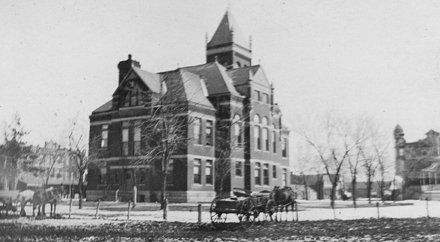
In 1875, Greenfield became the county seat, after a heated and protracted contraversy with neighboring Fontanelle (originally names Summerset),with the courthouse was built on the current site of the Warren Cultural Center. The existing Adair County Courthouse was built in 1891. The nation's wars have taken their toll on artifacts surrounding the structure. A gazebo on the south lawn was burned during a WWI victory celebration and cannons that once decorated both entrances were melted down during a WWII scrap iron drive.
The year 1875 also saw the introduction of the town's first newspaper. The Greenfield Transcript was printed in an upper room of Littleton's store. The first issue, published July 2, 1875, was an eight-column folio with one side published and printed in Chicago.
The Transcript was short-lived, however, and in 1889 E.J. Sidey established the Adair County Democrat. The Democrat later became an independent media: The Adair County Free Press.
The first permanent church structure was erected in 1877 by the Methodist Episcopal parishinoers.
A grand courthouse, the seat of today's county governemnt, was erected in 1896 in the center of the town square, now listed on the National Register of Historic Places.
The Greenfield Electric Light Plant began electrifying the town in 1890, one of the few in the state at the time. The lights were on from sundown to 11 p.m. daily, and 5 a.m. to sun-up in the winter. The first local telephone system was established in 1896 with about 20 line phones. Greenfield Municipal Utilities is the third oldest continuously operated municipal utility in Iowa.
It was in this environment, in 1896, that E.E. Warren and his wife, Eva, built the E.E. Warren Opera House and Warren Dry Goods Store on the east side of the Square. The three-story structure with its decorative turret has dominated the Greenfield skyline for more than 100 years. In its early years, the Opera House hosted traveling theatrical troupes, medicine shows, musical productions and local theatre. Mrs. Warren was a stanch supporter of the arts and an accomplished musician in her own right. The upper floors of the building gradually declined in usage, but the ground floor remained in use as retail space until 1990. It was placed on the National Register of Historic Places in 1979. In 2012, the Opera House, along with the adjoining Hetherington and Taylor buildings reopened as the Warren Cultural Center, a multi-use center of culture and commerce that includes an auditorium and historic rooms, gallery, and office space. Ed & Eva’s, a retail establishment devoted to the work of Iowa artists, occupies the space created for the Warren Dry Goods Store.
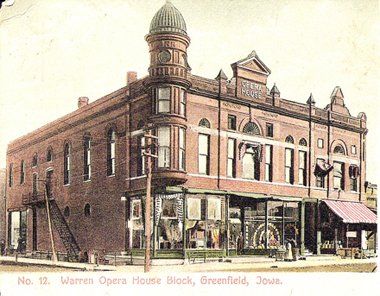

The first move to establish a public library in Greenfield also took place in 1896, but it was not until 1916 that the task was finally accomplished with the help of the Progress Club. It was the women of the town, exercising their newly acquired right to vote, who made the effort reality. The Carnegie library remained in use until 1997 when the library and city hall merged into new accommodations.
In 1920, a number of Greenfield businessmen established Hotel Greenfield at a cost of $60,000. In 2011 it was again a group of local investors, ADCO Enterprises, who brought the place back to its former glory with boutique-style lodging and on-site eatery.
The Great Depression and two World Wars took their toll on the community, yet it still continued to grow. The golf and country club opened in 1924. A volunteer fire department was formed and a fire truck purchased in 1926. The public swimming pool, still in use, was built as a WPA project in 1941.
A movement to build a county general hospital was initiated by the Greenfield Service Club at the end of WWII. The project was completed in 1950. The facility is periodically renovated and today Adair County Health System provides state-of-the-art in- and out-patient services.

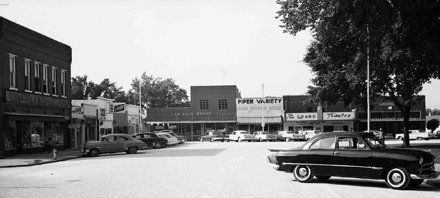
The 1950s and 1960s portrayed a Rockwellian version of American life. Saturday Night on the square offered a variety of commerce, a movie to see, a good meal at a small town café, and a snow cone or popcorn from Eddie's Super Popcorn Stand. It was a time for town and countryside people to gather for both business and social reasons. And the Friday night high school football game was the hottest show in town.
In 1969, Hollywood producer Norman Lear discovered Greenfield's charm and used it as the primary set for the movie "Cold Turkey." Starring Dick Van Dyke, Jean Stapleton, Bob Newhart and Tom Poston, the movie involved a town that accepted a challenge to quit smoking for 30 days. Greenfield also rose to the challenge and went "Cold Turkey" with 166 of its citizens signing Stop Smoking pledges. In 1999, a "Cold Turkey" reunion was held, with Lear and a number of original cast members returning.
In 1974, Cardinal Insulated Glass established a factory and quickly became the largest employer. Siegwerk Inc, an ink processing plant, joined Cardinal in the industrial park, now QuadGraphics CR\T.
Another major employer in town, Schildberg Construction Company Inc., has been a part of the community since 1937. The family-owned company, which operates 20 limestone quarries throughout Southwest Iowa and NW Missouri, maintains its corporate headquarters in Greenfield.
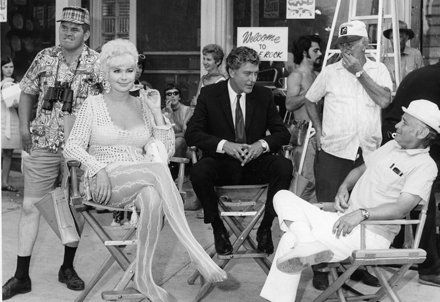
The Schildberg family has been a generous force, donating private collections to create the Iowa Aviation Museum one mile north of Greenfield and the Dennis and Marlene Schildberg Antique Car collection on the east side of the Square. Yvonne Schildberg purchased and donated the deteriorated Opera House for its 2012 restoration.
Greenfield has hosted RAGBRAI, the Des Moines Register's Annual Great Bicycle Ride Across Iowa on three times in the ride’s history.
In 1987, US presidential candidate Jesse Jackson visited Greenfield and the farm of Dixon C. Terry at a time when the farm econoy was in shambles. He received major positive feedback on his intent to revitalize the farm sector with a New Deal-style farm policy. This prompted him to establish his state campaign headquarters in downtown Greenfield. Jackson was the first African-American to conduct a viable and near successful campaign for president. Somewhat ironically, Greenfield had been the de facto Iowa headquarters for the Ku Klux Klan in the earlier years ofthe century.
In 1995, Greenfield became affiliated with the Main Street Iowa program and became a designated Main Street community. The organization offers consultation and expertise in preserving and rejuvenating the downtown area.
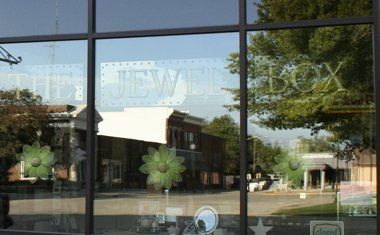
The 21st Century has seen a surge of rejuvenation with the downtown streetscape with acclaimed restorations of Hotel Greenfield and the Warren Cultural Center, The Adair County Health System continues to offer a wide variety of medical services. A new Adair County Law Enforcement Center that replaces the 1903 jail.
Building on its rich history of resourceful enterprise and civic services, Greenfield looks forward to the future as the place to be – for Commercial Entrepreneurship.
For Recreation and Good Times, for Quality of Life.
For Life. For Business. For Fun.
From its Lancaster Square filled with thriving shops and businesses to the surrounding tranquil rural countryside, Greenfield offers a world of good living and opportunity. Its 2,000 citizens pride themselves on community involvement - constantly working to improve the quality of life for people of all ages.
Attractions bring people from afar and offer cultural and historical context for local patrons.
The Main Street Iowa program helps maintain a sound economic base. Just 55 miles from Des Moines, 80 miles from Omaha, and a short drive from Interstate 80, Greenfield is situated at the crossroads of two state highways and maintains a municipal airport.
Greenfield is a center of culture and commerce in the middle of farm country.
THERE’S NOTHING LIKE IT.
GET IN TOUCH:
Greenfield Chamber Main Street
& Community Development
City of Greenfield
(844) 580-0810 option 1
202 South First Street
Greenfield, Iowa 50849
You can also find us here:

All Rights Reserved | Greenfield Chamber Main Street
Privacy & Terms | Powered By : Chamber Nation
